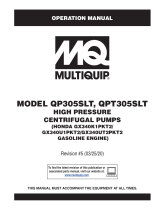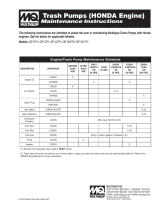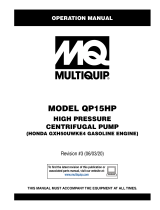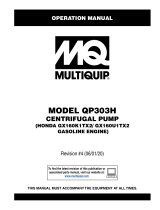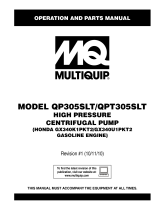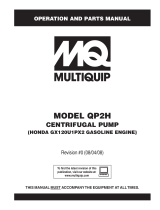
OPERATION AND PARTS MANUAL
© COPYRIGHT 2003, MULTIQUIP INC.
MODEL
SDP-2/SDP-3
DIAPHRAGM PUMPS
PARTS DEPARTMENT:
800-427-1244
FAX: 800-672-7877
SERVICE DEPARTMENT/TECHNICAL ASSISTANCE:
800-478-1244
FAX: 310-631-5032
STOW CONSTRUCTION EQUIPMENTSTOW CONSTRUCTION EQUIPMENT
STOW CONSTRUCTION EQUIPMENTSTOW CONSTRUCTION EQUIPMENT
STOW CONSTRUCTION EQUIPMENT
A DIVISION OF MULTIQUIP INC.
POST OFFICE BOX 6254
CARSON, CA 90749
310-537-3700 • 888-252-STOW [888-252-7869]
FAX: 310-537-1986 • FAX: 800-556-1986
E-MAIL: [email protected] • WWW: stowmfg.com
Revision #2 (11/16/03)

PAGE 2 — STOW SDP-2 / SDP-3 DIAPHRAGM PUMP — PARTS MANUAL — REV. #2 (12/16/03)

STOW SDP-2 / SDP-3 DIAPHRAGM PUMP — PARTS MANUAL— REV. #2 (12/16/03) — PAGE 3
HERE'S HOW TO GET HELP
PLEASE HAVE THE MODEL AND SERIAL
NUMBER
ON-HAND
WHEN CALLING
PARTS DEPARTMENT
800-427-1244 FAX: 800-672-7877
310-537-3700 FAX: 310-637-3284
SERVICE DEPARTMENT
800-478-1244 FAX: 310-537-4259
310-537-3700
TECHNICAL ASSISTANCE
800-478-1244 FAX: 310-631-5032
WARRANTY DEPARTMENT
800-421-1244, EXT. 279 FAX: 310-537-1173
310-537-3700, EXT. 279
SALES DEPARTMENT
310-661-4242 FAX: 310-604-9237
877-289-7869 (877-BUY-STOW)

PAGE 4 — STOW SDP-2 / SDP-3 DIAPHRAGM PUMP — PARTS MANUAL — REV. #2 (12/16/03)
Specification and part number
are subject to change without
notice.
NOTE
STOW SDP-2/SDP-3
Gasoline Powered
Diaphragm Pumps
Here’s How To Get Help ............................................ 2
Table of Contents ...................................................... 3
Parts Ordering Procedures .................................... 4-5
Specifications (Pump/Engine) ....................................6
Pump Dimensions ......................................................7
Safety Message Alert Symbols .............................. 8-9
Rules For Safe Operation .................................. 10-11
General Information .................................................12
Pump Components ..................................................13
Basic Engine ............................................................14
Pre-Inspection (Engine) ...........................................15
Pre-Set-up (Pump) ............................................. 16-17
Initial Start-up (Engine) ...................................... 18-19
Maintenance (Pump) ......................................... 20-22
Maintenance (Engine)........................................ 23-24
Preparation for Long-Term Storage .........................25
Troubleshooting (Pump)...........................................26
Troubleshooting (Pump/Engine) ..............................27
Explanation Of Code In Remarks Column ...............28
Suggested Spare Parts ............................................29
HONDA GX120K1QX2 Engine
Air Cleaner Assembly......................................... 40-41
Camshaft Assembly ........................................... 42-43
Carburetor Assembly ......................................... 44-45
Control Assembly ............................................... 46-47
Crankcase Cover Assembly ............................... 48-49
Crankshaft Assembly ......................................... 50-51
Cylinder Barrel Assembly ................................... 52-53
Cylinder Head Assembly .................................... 54-55
Fan Cover Assembly .......................................... 56-57
Flywheel Assembly ............................................ 58-59
Fuel Tank Assembly ........................................... 60-61
Ignition Coil Assembly ........................................ 62-63
Muffler Assembly ............................................... 64-65
Piston Assembly ................................................. 66-67
Recoil Starter Assembly..................................... 68-69
Gasket Kit Assembly .......................................... 70-71
Labels ................................................................ 72-73
Terms and Condition Of Sale
— Parts .................... 74
STOW SDP-2/SDP-3 — TABLE OF CONTENTS
As a continuing effort to update
our parts book, contact the
STOW literature department for
the latest revision of your
"Operation and Parts Manual"
NOTE
Component Drawings
Water Box and Groove Assy. (2-inch) ................ 30-31
Pump Assy. (2-inch) ........................................... 32-33
Water Box and Groove Assy. (3-inch) ................ 34-35
Pump Assy. (3-inch) ........................................... 36-37
Axle, Handle, Engine Mtg. and Bumper Assy. ... 38-39

STOW SDP-2 / SDP-3 DIAPHRAGM PUMP — PARTS MANUAL— REV. #2 (12/16/03) — PAGE 5
PARTS ORDERING PROCEDURES
When ordering parts,
please supply the following information:
❒❒
❒❒
❒ Dealer account number
❒❒
❒❒
❒ Dealer name and address
❒❒
❒❒
❒ Shipping address (if different than billing address)
❒❒
❒❒
❒ Return fax number
❒❒
❒❒
❒ Applicable model number
❒❒
❒❒
❒ Quantity, part number and description of each part
❒❒
❒❒
❒ Specify preferred method of shipment:
✓ FedEx or UPS Ground
✓ FedEx or UPS Second Day or Third Day
✓ FedEx or UPS Next Day
✓ Federal Express Priority One
✓ DHL
✓ Tr uck
Here’s how to get help...
Please have the model and serial number on
hand when calling.
Parts Department
800-427-1244 Fax: 800-672-7877
310-537-3700 Fax: 310-637-3284
Service Department
800-478-1244 Fax: 310-537-4259
310-537-3700
Technical Assistance
800-478-1244 Fax: 310-631-5032
Warranty Department
800-421-1244, Ext. 279 Fax: 310-537-1173
310-537-3700, Ext. 279
Sales Department
310-661-4242 Fax: 310-604-9237
877-289-7869 (877-BUY-STOW)
Note: Unless otherwise indicated by customer, all
orders are treated as “Standard Orders”, and will
ship within 24 hours. We will make every effort to
ship “Air Shipments” the same day that the order is
received, if prior to 2PM west coast time. “Stock
Orders” must be so noted on fax or web forms.
Extra Discounts!
All parts orders which include complete part numbers
and are received by our automated web parts order
system, or by fax qualify for the following extra
discounts:
Ordered Standard Stock orders
via orders ($750 list and above)
Fax 3% 10%
Web 5% 10%
Special freight allowances
when you order 10 or more
line items via Web or Fax!**
FedEx Ground Service
at no charge for freight
No other allowances on freight shipped by any other
carrier.
Place Your Parts Order Via Web or Fax
For Even More Savings!
NOTE: DISCOUNTS ARE SUBJECT TO CHANGE
Direct TOLL-FREE access
to our Parts Department:
Toll-free nationwide — 800-427-1244
STOW CONSTRUCTION EQUIPMENTSTOW CONSTRUCTION EQUIPMENT
STOW CONSTRUCTION EQUIPMENTSTOW CONSTRUCTION EQUIPMENT
STOW CONSTRUCTION EQUIPMENT
A DIVISION OF MULTIQUIP INC.
POST OFFICE BOX 6254
CARSON, CA 90749
310-537-3700 • 888-252-STOW [888-252-7869]
FAX: 310-537-1986 • FAX: 800-556-1986
E-MAIL: [email protected] • WWW: stowmfg.com

PAGE 6 — STOW SDP-2 / SDP-3 DIAPHRAGM PUMP — PARTS MANUAL — REV. #2 (12/16/03)
STOW SDP-2/SDP-3 — SPECIFICATIONS (PUMP/ENGINE)
)pmuP(snoitacificepS.1elbaT
pmuP
epyTpmuPmgarhpaiD2-PDSpmuPmgarhpaiD3-PDS
egrahcsiD&noitcuS
eziS
).mm8.05(.ni00.2).mm2.67(.ni00.3
gnipmuPmumixaM
yticapaC
ruoh/snollag000,3
)ruoh/sretil043,11(
ruoh/snollag001,5
)ruoh/sretil023,91(
retemaiDsdlioS.xaM)mm4.52(.ni1)mm8.05(ni2
tfiLxaM)sretem29.7(.tf62)sretem29.7(.tf62
daeH.xaM)sretem45.51(.tf15)sretem45.51(.tf15
thgieWteNyrD
).gK36(.sbl041
).gK27(.sbl061
)enignE(snoitacificepS.2elbaT
enignE
ledoM2XQ1K021XGADNOH
epyT
elgniS,ekorts4delooc-riA
latnoziroH,VHO,rednilyC
enignEenilosaGtfahS
ekortSXeroB
.ni7.1x.ni4.2
)mm24xmm06(
tnemecalpsiD)ni-uc2.7(cc911
tuptuOxaM.M.P.R0063/.P.H0.4
yticapaCknaTleuF)sretil5.2(.lagSU66.0
leuF
elibomotuAdedaelnU
enilosaG
yticapaCliOebuL)stq36.0(sretil06.
lortnoCdeepS
dohteM
epyTthgiew-ylFlagufirtneC
dohteMgnitratStratSlioceR
noisnemiD
)HxWxL(
.ni5.21x4.31x7.11
)mm813x143x792(
yrD
thgieWteN
).gK31(sbl7.82

STOW SDP-2 / SDP-3 DIAPHRAGM PUMP — PARTS MANUAL— REV. #2 (12/16/03) — PAGE 7
STOW SDP-2/SDP-3 — DIMENSIONS (PUMP)
snoisnemiD.3elbaT
LEDOM
A
HTGNEL
B
THGIEH
C
HTDIW
D
EGRAHCSID
E
NOITCUS
2-PDS
.ni78.93
).mc1.101(
.ni57.42
).mc68.26(
.ni57.42
).mc68.26(
.ni39.4
).mc25.21(
.ni52.4
).mc08.01(
3-PDS
.ni78.93
).mc1.101(
.ni86.32
).mc41.06(
.ni52.92
).mc03.47(
.ni52.5
).mc33.31(
.ni34.5
).mc08.31(
Figure 1. STOW SDP-2/SDP-3 Pump Dimensions

PAGE 8 — STOW SDP-2 / SDP-3 DIAPHRAGM PUMP — PARTS MANUAL — REV. #2 (12/16/03)
STOW SDP-2/SDP-3 — SAFETY MESSAGE ALERT SYMBOLS
Safety precautions should be followed at all times when operating
this equipment. Failure to read and understand the Safety
Messages and Operating Instructions could result in injury to
yourself and others.
FOR YOUR SAFETY AND THE SAFETY OF OTHERS!
This Owner's Manual has been
developed to provide complete
instructions for the safe and
efficient operation of the
STOW
Model SDP-2
and
SDP-3
Diaphragm Pumps.
Refer to the
engine manufacturers instructions
for data relative to its safe
operation.
Before using these pumps, ensure that the operating
individual has read and understands all instructions in this
manual.
SAFETY MESSAGE ALERT SYMBOLS
The three (3) Safety Messages shown below will inform you
about potential hazards that could injure you or others. The
Safety Messages specifically address the level of exposure to
the operator, and are preceded by one of three words: DANGER,
WARNING, or CAUTION.
DANGER: You WILL be KILLED or
SERIOUSLY injured if you do not follow
WARNING: You CAN be KILLED or
SERIOUSLY injured if you do not follow
directions.
CAUTION: You CAN be injured if you
do not follow directions.
Engine exhaust gases contain poisonous
carbon monoxide. This gas is colorless and
odorless, and can cause death if inhaled.
NEVER operate this equipment in a confined
area or enclosed structure that does not
provide ample free flow air.
Potential hazards associated with the STOW SDP-2/SDP-3
diaphragm pumps operation will be referenced with Hazard
Symbols which appear throughout this manual, and will be
referenced in conjunction with Safety Message Alert Symbols.
GASOLINE is extremely flammable, and its
vapors can cause an explosion if ignited. DO
NOT start the engine near spilled fuel or
combustible fluids. DO NOT fill the fuel tank
while the engine is running or hot. DO NOT
overfill tank, since spilled fuel could ignite if it
comes into contact with hot engine parts or
sparks from the ignition system. Store fuel in
approved containers, in well-ventilated areas
and away from sparks and flames. NEVER
Explosive Fuel
Lethal Exhaust Gases
Burn Hazards
Engine components can generate extreme heat.
To prevent burns, DO NOT touch these areas
while the engine is running or immediately after
operations. Never operate the engine with heat
shields or heat guards removed.
Rotating Parts
NEVER operate equipment with covers, or
guards removed. Keep fingers, hands, hair and
clothing away from all moving parts to prevent
injury.
HAZARD SYMBOLS
NOTE

STOW SDP-2 / SDP-3 DIAPHRAGM PUMP — PARTS MANUAL— REV. #2 (12/16/03) — PAGE 9
Accidental Starting
STOW SDP-2/SDP-3 — SAFETY MESSAGE ALERT SYMBOLS
ALWAYS place the engine ON/OFF switch in
the OFF position when the pump is not in use.
Respiratory Hazard
ALWAYS wear approved respiratory
protection.
Equipment Damage Messages
Other important messages are provided throughout this manual
to help prevent damage to your pump, other property, or the
surrounding environment.
ALWAYS wear approved eye and hearing
protection.
Sight and Hearing hazard
This pump, other property, or the
surrounding environment could be
damaged if you do not follow
instructions.
NOTE
To avoid injuries and damage to the
equipment,
ALWAYS
read and understand
contents of operation manual before operating
equipment.
WARNING

PAGE 10 — STOW SDP-2 / SDP-3 DIAPHRAGM PUMP — PARTS MANUAL — REV. #2 (12/16/03)
STOW SDP-2/SDP-3 — RULES FOR SAFE OPERATION
■
ALWAYS refuel in a well-ventilated area, away from sparks
and open flames.
■
ALWAYS use extreme caution when working with flammable
liquids. When refueling, stop the engine and allow it to cool.
DO NOT
smoke around or near the machine. Fire or explosion
could result from fuel vapors, or if fuel is spilled on a hot
engine.
■
NEVER operate the pump in an
explosive
atmosphere
or near combustible
materials. An explosion or fire could result
causing severe
bodily harm or even
death.
■
Topping-off to filler port is dangerous, as it tends to spill fuel.
■
Refer to the
Engine Owner's Manual
for engine technical
questions or information.
■
NEVER use accessories or attachments, which are not
recommended by Multiquip for this equipment. Damage to
the equipment and/or injury to user may result.
■
Manufacturer does not assume responsibility for any accident
due to equipment modifications.
■
NEVER touch the hot exhaust manifold,
muffler or cylinder. Allow these parts to
■
The engine of this pump requires an adequate free flow of
cooling air.
NEVER!
operate the pump in any enclosed or
narrow area where free flow of the air is restricted. If the air
flow is restricted it will cause
serious damage to the
pump or engine and may
cause injury to people and
property. Remember the
pump's engine gives off
DEADLY gases.
■
High Temperatures – Allow the engine to cool before adding
fuel or performing service and maintenance functions. Contact
with
hot
components can cause serious burns.
Failure to follow instructions in this manual may
lead to serious injury or even death! This
equipment is to be operated by trained and
qualified personnel only! This equipment is for
industrial use only.
The following safety guidelines should always be used when
operating the
Diaphragm Pump
:
GENERAL SAFETY
■
DO NOT operate or service this equipment before
reading this entire manual.
■
This equipment should not be operated by
persons under 18 years of age.
■
NEVER operate this equipment without proper
protective clothing, shatterproof glasses, steel-
toed boots and other protective devices required
by the job.
■
NEVER operate this equipment when not feeling
well due to fatigue, illness or taking medicine.
■
NEVER operate this equipment under the
influence or drugs or alcohol.
■
Whenever necessary, replace nameplate, operation and safety
decals when they become difficult read.
■
ALWAYS check the machine for loosened threads or bolts
before starting.
■
ALWAYS wear proper respiratory (mask) hearing and eye
protection equipment when operating the pump.
DANGER:

STOW SDP-2 / SDP-3 DIAPHRAGM PUMP — PARTS MANUAL— REV. #2 (12/16/03) — PAGE 11
■
High Temperatures – Always stop engine and allow the
engine to cool before adding fuel, oil or performing service
and maintenance functions. Contact with
hot
components can
cause serious burns.
■
NEVER disconnect any
"emergency or safety devices"
.
These devices are intended for operator safety. Disconnection
of these devices can cause severe injury, bodily harm or even
death! Disconnection of any of these devices will void all
warranties.
Maintenance Safety
■
NEVER lubricate components or attempt service on a running
machine.
■
ALWAYS allow the machine a proper amount of time to cool
before servicing.
■
Keep the machinery in proper running condition.
■
Fix damage to the machine immediately and always replace
broken parts, or missing decals.
■
Dispose of hazardous waste properly. Examples of potentially
hazardous waste are used motor oil, fuel and fuel filters.
■
DO NOT use food or plastic containers to dispose of
hazardous waste.
■
DO NOT pour waste, oil or fuel directly onto the ground,
down a drain or into any water source.
Emergencies
■
ALWAYS know the location of the
nearest
fire extinguisher
.
■
ALWAYS know the location of the nearest
first aid kit
.
■
In emergencies
always
know the location of the
nearest phone or
keep a phone on the job site
.
Also know the phone numbers of the nearest
ambulance
,
doctor
and
fire department
. This
information will be invaluable in the case of an
emergency.
■
NEVER Run engine without air cleaner. Severe engine
damage may occur.
■
ALWAYS read, understand, and follow procedures in
Operator’s Manual before attempting to operate equipment.
■
ALWAYS be sure the operator is familiar with proper safety
precautions and operation techniques before using pump.
■
ALWAYS store equipment properly when it is not being used.
Equipment should be stored in a clean, dry location out of the
reach of children.
■
NEVER leave the pump unattended, turn off engine when
unattended.
■
Unauthorized equipment modifications will void all
warranties.
■
NEVER pump volatile, explosive, flammable or low flash point
fluids. These fluids could ignite or explode.
■
NEVER operate the pump in an
explosive
atmosphere.
■
Before starting the pump, check that the clean-out cover is
securely fasten.
■
ALWAYS ensure pump is on level ground before use.
■
Become familiar with the components of the pump before
operating.
■
ALWAYS replace any worn or damaged warning decals.
■
NEVER pump corrosive chemicals or water containing toxic
substances. These fluids could create serious health and
environmental hazards. Contact local authorities for
assistance.
■
NEVER open the priming plug when pump is hot. Hot water
inside could be pressurized much like the radiator of an
automobile. Allow pump to cool to the touch before loosening
plug.
■
NEVER open the pump housing during operation or start the
pump with the clean-out cover removed. The rotating impeller
inside the pump can cut or sever objects caught in it.
■
NEVER block or restrict flow from discharge hose. Remove
kinks from discharge line before starting pump. Operation
with a blocked discharge line can cause water inside pump
to overheat.
■
ALWAYS fill the pump casing with water before starting the
engine. Failure to maintain water inside the pump housing
will cause severe damage to the pump.
■
In winter drain water from pump housing to prevent freezing.
STOW SDP-2/SDP-3 — RULES FOR SAFE OPERATION

PAGE 12 — STOW SDP-2 / SDP-3 DIAPHRAGM PUMP — PARTS MANUAL — REV. #2 (12/16/03)
STOW SDP-2/SDP-3 — GENERAL INFORMATION
APPLICATION
The
STOW Model SDP-2
and
SDP-3 diaphragm
pumps are
designed to be used for de-watering applications. The suction
and discharge ports on the
SDP-2
use a 2-inch diameter opening,
which allows the pump to pump at rate of approximately 3,000
gallons/hour (gph) or 11,340 liters/hour (lph). The suction and
discharge ports on the
SDP-3
use a 3-inch diameter opening,
which allows the pump to pump at rate of approximately 5,100
gallons/hour (gph) or 19,320 liters/hour (lph).
Diaphragm pumps use a positive displacement design rather
than centrifugal force to move water through the casing. This
means the pump will deliver a specific amount of flow per stroke,
revolution or cycle. These pumps are commonly referred to as
mud hogs, mud hens and mud suckers. Their names reflect their
popularity for use in applications where shallow depths and slurry
water render centrifugal pumps ineffective
Power Plant
These diaphragm pumps are powered by an 4.0 horsepower air
cooled, 4-stroke, single cylinder
HONDA GX-120
gasoline engine
that incorporates a low "
Oil Alert Feature
" . The drive shaft of the
engine is coupled to an offset connecting rod that is coupled to a
flexible diaphragm. The connecting rod alternately raises
(expands) and lowers (contracts) the diaphragm at a rate
between 40 and 65 strokes per minute depending on engine
speed.
Oil Alert Feature
In the event of
low oil
or
no oil
, the HONDA GX-120 engine has
a built-in oil alarm engine shut-down feature. In the event the oil
level is low the engine will automatically shut-down.
Suction Lift
This pump is intended to be used for dewatering applications
and is capable of suction lifts up to 25 feet at sea level. For optimal
suction lift performance keep the suction hose or line as short as
possible. In general always place the pump as close to the water
as possible.
Pump Support
The pump should always be placed on
solid stationary ground
in a level position.
NEVER place the pump on
soft soil
. The suction hose or pipe
connection should always be checked for tightness and leaks. A
small suction leak in the hose or fittings could prevent the pump
from priming.
Elevation
Higher elevations will effect the performance of the pump. Due to
less atmospheric pressure at higher altitudes, pumps DO NOT
have the priming ability that they have at sea level. This is due to
the “thinner air” or lack of oxygen at higher altitudes.
A general rule of thumb is that for every 1,000 feet of elevation
above sea level a pump will lose one foot of priming ability.
For example, in Flagstaff, Arizona where the elevation is
approximately 7,000 feet, the pump would have a suction lift of
only 18 feet rather than the 25 feet at sea level. Table 3 shows
suction lift at various elevations.
Table 4 shows percentage drops in performance as elevation
increases.
suoiraVtassoLecnamrofreP.4elbaT
snoitavelE
edutitlA
sreteM(teeF
wolFegrahcsiDdaeHegrahcsiD
leveLaeS%001%001
)016(000,2%79%59
)912,1(000,4%59%19
)928,1(000,6%39%78
)834,2(000,8%19%38
)840,3(000,01%88%87
snoitavelEsuoiraVtatfiLnoitcuS.3elbaT
edutitlA
)sreteM(teeF
)sreteM(teeFnitfiLnoitcuS
leveLaeS)840.3(0.01)275.4(0.51)690.6(0.02)026.7(0.52
)016(000,2)086.2(08.8)320.4(2.31)463.5(6.71)507.6(0.22
)912,1(000,4)773.2(08.7)665.3(7.11)457.4(6.51)349.5(5.91
)928,1(000,6)301.2(09.6)961.3(4.01)602.4(8.31)372.5(3.71
)834,2(000,8)988.1(02.6)438.2(03.9)977.3(4.21)427.4(5.51
)840,3(000,01)737.1(07.5)126.2(06.8)474.3(4.11)853.4(3.41

STOW SDP-2 / SDP-3 DIAPHRAGM PUMP — PARTS MANUAL— REV. #2 (12/16/03) — PAGE 13
Figure 2 shows a typical application using the STOW SDP-2 or SDP-3 diaphragm pump. Please note that this pump is intended for
the removal of clean water and water containing some debris and solids. Maximum size of solids should not exceed 1 inch (25 mm)
in diameter. DO NOT set strainer on bottom of water bed. Placing the strainer above the water bed will prevent the pump from
drawing in excessive amounts of sand and foreign debris.
1. Pump – The STOW Models SDP-2 and SDP-3 are 2-inch
and 3-inch diaphragm pumps respectively and are used in
general de-watering applications. Typical dewatering
applications consist of cleaning out cesspools and septic
tanks, draining slow seepage from small excavations,
trenches and construction sites, or pumping out industrial
waste.
2. Fill Cap – Prior to operation, the pump casing should be
filled with water. Remove this cap to add water to the pump.
After the initial prime, a sufficient amount of water will be
retained in the casing so that the operator will not need to
re-prime later.
If the casing is dry or has insufficient water, the pump will
have difficulty in priming which could lead to premature
mechanical seal wear thus causing damage to the pump.
3. Discharge Port – Connect a either a 2-inch, and 3-inch
discharge hose to this port depending on pump model.
4. Worm Clamp – Used to secure the hose to the inlet and
outlet ports on the pump. Use two clamps to secure the
hose on the inlet side of the pump.
5. Discharge Hose – Connect a flexible rubber hose to the
discharge port on the pump. Make sure that the hose lays
flat and is not kinked. Use only recommended type
discharge hose. Contact Multiquip parts department for
ordering information.
Figure 2. STOW SDP-2/SDP-3 Pump Application
STOW SDP-2/SDP-3 — PUMP COMPONENTS
6. Suction Port – Connect either a 2-inch or 3-inch inlet
hose to this port depending on pump model. Use two worm
clamps to secure the hose.
7. Suction Hose – Connect a flexible rubber hose to the
suction port on the pump. Make sure that the hose lays flat
and is not kinked. Use only recommended type suction hose.
Contact Multiquip parts department for ordering information
8. Strainer – Always attach a strainer to bottom side of the
suction hose to prevent large objects and debris from
entering the pump. Strainer should be positioned so that it
will remain completely under water. Running the pump with
the strainer above water for long periods can damage pump.
9. Transmission Oil Fill Plug – Remove this plug to add
SAE 80/90 EP gear oil to the transmission. Transmission oil
capacity is 1-1/4 pints (550 ml.).
10. Connecting Rod Grease Access Hole – Grease
connecting rod bearing through this access hole. Grease
connecting rod bearing every 25 hours of operation.
NOTE
Contact your nearest Multiquip
dealer for quick disconnect hoses
and fittings.

PAGE 14 — STOW SDP-2 / SDP-3 DIAPHRAGM PUMP — PARTS MANUAL — REV. #2 (12/16/03)
STOW SDP-2/SDP-3 — BASIC ENGINE
Figure 3. Engine Controls and Components
INITIAL SERVICING
The engine (Figure 3) must be checked for proper lubrication and
filled with fuel prior to operation. Refer to the manufacturers engine
manual for instructions & details of operation and servicing. The
engine shown above is a HONDA engine, operation for other
types of engines may vary somewhat.
1. Fuel Filler Cap – Remove this cap to add unleaded
gasoline to the fuel tank. Make sure cap is tightened
securely. DO NOT over fill.
6. Choke Lever – Used in the starting of a cold engine, or in
cold weather conditions. The choke enriches the fuel
mixture.
7. Air Cleaner – Prevents dirt and other debris from entering
the fuel system. Remove wing-nut on top of air filter
cannister to gain access to filter element.
8. Spark Plug – Provides spark to the ignition system. Set
spark plug gap to 0.6 - 0.7 mm (0.028 - 0.031 inch) Clean
spark plug once a week.
9. Muffler – Used to reduce noise and emissions.
Engine components can generate extreme heat.
To prevent burns, DO NOT touch these areas
while the engine is running or immediately after operating. NEVER
operate the engine with the muffler removed.
10. Fuel Tank – Holds unleaded gasoline. For additional
information refer to engine owner's manual.
DANGER
Operating the engine without an
air filter, with a damaged air filter,
or a filter in need of replacement
will allow dirt to enter the engine,
causing rapid engine wear.
WARNING
Adding fuel to the tank should be done only when
the engine is stopped and has had an opportunity to
cool down. In the event of a fuel spill, DO NOT attempt to start the
engine until the fuel residue has been completely wiped up, and the
area surrounding the engine is dry.
2. Throttle Lever – Used to adjust engine RPM speed (lever
advanced forward
SLOW
, lever back toward operator
FAST
).
3. Engine ON/OFF Switch – ON position permits engine
starting, OFF position stops engine operations.
4. Recoil Starter (pull rope) – Manual-starting method. Pull
the starter grip until resistance is felt, then pull briskly and
smoothly.
5. Fuel Valve Lever – OPEN to let fuel flow, CLOSE to stop
the flow of fuel.
NOTE

STOW SDP-2 / SDP-3 DIAPHRAGM PUMP — PARTS MANUAL— REV. #2 (12/16/03) — PAGE 15
STOW SDP-2/SDP-3 — PRE-INSPECTION (ENGINE)
Figure 4. Engine Oil Dipstick (Removal)
3. Insert and remove the dipstick without screwing it into the filler
neck. Check the oil level shown on the dipstick.
4. If the oil level is low (Figure 5), fill to the edge of the oil filler
hole with the recommended oil type (Table 5). Maximum oil
capacity is 1.16 quarts (1.1 liters)
Figure 5. Engine Oil Dipstick (Oil Level)
Before Starting
1. Read safety instructions at the
beginning of manual.
2. Clean the pump, removing dirt and
dust, particularly the engine
cooling air inlet, carburetor and air
cleaner.
3. Check the air filter for dirt and dust. If air filter is dirty, replace
air filter with a new one as required.
4. Check carburetor for external dirt and dust. Clean with dry
compressed air.
5. Check fastening nuts and bolts for tightness.
Engine Oil Check
1. To check the engine oil level, place the pump on secure
level ground with the engine stopped.
2. Remove the filler dipstick from the engine oil filler hole
(Figure 4) and wipe clean.
CAUTIONCAUTION
CAUTIONCAUTION
CAUTION
NEVER operate the pump in
a confined area or enclosed
area structure that does not
provide ample
free flow of
air
.
ALWAYS wear approved eye and hearing
protection before operating the pump.
Fuel Check
1. Remove the gasoline cap located on top of fuel tank.
2. Visually inspect to see if the fuel level is low. If fuel is low,
replenish with unleaded fuel.
3. When refueling, be sure to use a strainer for filtration. DO
NOT top-off fuel. Wipe up any spilled fuel
immediately!
Explosive Fuel
DANGERDANGER
DANGERDANGER
DANGER
Motor fuels are highly flammable and can be
dangerous if mishandled. DO NOT smoke
while refueling. DO NOT attempt to refuel the
pump if the engine is
hot!
or
running
.
epyTliO.5elbaT
nosaeS erutarepmeT epyTliO
remmuS rehgiHroC°52 03-W01EAS
llaF/gnirpS C°01~C°52 02/03-W01EAS
retniW rewoLroC°0 01-W01EAS

PAGE 16 — STOW SDP-2 / SDP-3 DIAPHRAGM PUMP — PARTS MANUAL — REV. #2 (12/16/03)
Before Starting
1. Read safety instructions at the
beginning of manual.
2. Place pump as near to water as
possible, on a firm flat, level surface.
3. To prime pump, remove fill cap (Figure 2) and fill pump casing
with water. If the pump casing is not filled with water before
starting, it will not begin pumping.
STOW SDP-2/SDP-3 — PRE-SETUP (PUMP)
4. Check for
leaks
between pump and engine. If water is leaking
between the pump and engine housing, the seal inside the
pump may be worn or damaged. Continued operation of the
pump is not recommended. Further usage of the pump under
these conditions may cause severe water damage to engine.
Hoses and Clamps
1. Check that all hoses are
securely
attached to the pump.
Make certain suction hose (Figure 2) does not have any air
leakage. Tighten hose clamps and couplings as required.
2. It is recommended that 2 clamps be used when securing the
suction hose to the inlet side (suction) of the pump.
3. Remember suction hoses must be
rigid
enough not to
collapse when the pump is in operation.
4. Check that
the
discharge
hose (Figure 2) is not restricted.
Place hose so that it lays as straight as it is possible on the
ground. Remove any twists or sharp bends from hose which
may block the flow of water.
CAUTION :
Pump casing
must
be filled with water
before using pump. Otherwise pump will not
be able to begin pumping.
DO NOT open
fill cap
if pump is hot! Water
inside may be under pressure.
WARNING :
NOTE
Suction and discharge hoses are
available from Multiquip. Contact
your nearest dealer for more
information.
5. The discharge hose is usually a
collapsible
(thin-walled)
hose, however if a thin-walled discharge hose is not avail-
able, a rigid suction hose can be substituted in its place.
6. Make sure the
suction strainer
(Figure 2) is clean and
securely attached to the water end of the suction hose. The
strainer is designed to protect the pump by preventing large
objects from being pulled into the pump.
CAUTION :
The strainer should be positioned so it will
remain completely
under water
. Running the
pump with the strainer above water for long
periods can damage the pump.
CAUTION :
DO NOT pump flammable fluids, corrosive chemicals or fluids
containing toxic substances. These fluids can create potentially
dangerous health and environmental hazards. Contact local
authorities for assistance.
CAUTION :
This pump uses a water-cooled
mechanical
seal
to prevent water from seeping into the
engine. The passage of water through the pump
casing lubricates the seal and prevents it from
overheating.
NEVER!
operate the pump without
water in the casing as this will cause damage to the mechanical
seal.

STOW SDP-2 / SDP-3 DIAPHRAGM PUMP — PARTS MANUAL— REV. #2 (12/16/03) — PAGE 17
Gear Reduction Oil (Transmission)
1. Remove the transmission oil level plug (Figure 6). If oil
begins to seep out as the plug is being removed, then it
can be assumed that the transmission oil is at the proper
operating level.
2. If oil does not seep out as the oil level plug is being removed,
then remove the transmission oil fill plug and fill with
SAE 80/90
EP gear oil
to the proper operating level.
Transmission oil capacity is capacity is 1-1/4 pints (590 ml.).
STOW SDP-2/SDP-3 — PRE-SETUP (PUMP)
Connecting Rod Bearing Lubrication
1. Grease connecting rod bearing thru the acess hole
(Figure 7) every 25 hours of operation.
2. Use only
premium lithium based grease
, conforming to
NLG1 Grade #2 consistency.
Figure 6. Transmission Oil Level
Figure 7. Connecting Rod Bearing Lubrication
Helpful Hints
The capacity of this diaphragm pump will vary greatly depending on
the height of the suction lift and length of the discharge hose. A
discharge hose which is too small, long or high will cause the
following:
■
Excessive bulging of diaphragm on the down stroke.
■
Valves closing with a lould snap.
■
Rough operation.
■
Engine overloads and slow downs.
■
Reduced efficiency
NOTE
Diaphragm pumps will handle fluids
containing considerable solids (not to
exceed 1.00 inch/25 mm), however, if
the mixture is too heavy to be pumped,
water must be added until the mixture
becomes sufficently fluid for pumping.

PAGE 18 — STOW SDP-2 / SDP-3 DIAPHRAGM PUMP — PARTS MANUAL — REV. #2 (12/16/03)
6. Grasp the starter grip (Figure 13) and slowly pull it out. The
resistance becomes the hardest at a certain position, corre-
sponding to the compression point. Pull the starter grip briskly
and smoothly for starting.
Figure 13. Starter Grip
STOW SDP-2/SDP-3 — INITIAL START-UP (ENGINE)
Starting the Engine (
HONDA
engine)
1. Place the engine
fuel valve lever
(Figure 8) to the "ON"
position.
DO NOT attempt to operate the pump until the Safety, General
Information and Inspection sections of this manual have been
read and thoroughly understood
.
2. Move the
throttle lever
(Figure 9) away from the slow
position, about 1/3 of the way toward the fast position.
Figure 8. Engine Fuel Valve Lever (ON Position)
Figure 9. Throttle Lever (1/3 Start Position)
3. Place the
choke lever
(Figure 10) in the "OPEN " position if
starting a
cold
engine.
4. Place the
choke lever
(Figure 9) in the "CLOSED " position
if starting a
warm engine
or the
temperature is warm.
Figure 10. Engine
Choke Lever (Open)
Figure 11. Engine Choke Lever (Closed)
5. Place the
engine ON/OFF switch
(Figure 12) in the "ON "
position.
Figure 12. Engine ON/OFF Switch (ON Position)
This section is intended to assist the operator with the
initial
start-up
of the trash pump. It is extremely important that this
section be read carefully before attempting to use the pump in
the field.
CAUTION :

STOW SDP-2 / SDP-3 DIAPHRAGM PUMP — PARTS MANUAL— REV. #2 (12/16/03) — PAGE 19
STOW SDP-2/SDP-3 — INITIAL START-UP (ENGINE)
8. Before the pump is placed into operation, run the engine for
several minutes. Check for fuel leaks, and noises that would
associate with a lose component.
9.
To begin pumping, place the throttle lever (Figure 15) in the
"RUN" position.
Figure 14. Choke Lever (Closed)
Figure 15. Throttle Lever (Run)
Stopping The Engine
Normal Shutdown
1. Move the throttle lever to the IDLE position (Figure 16) and
run the engine for three minutes at low speed.
Figure 16. Throttle Lever (Idle)
2. After the engine
cools
, turn the engine ON/OFF switch to the
“OFF” position (Figure 17).
3. Place the
fuel shut-off lever
(Figure 18) in the ”OFF”
position.
Figure 17. Engine ON/OFF Switch (OFF)
Figure 18. Fuel Valve Lever (OFF)
Emergency Showdown
1. Move the throttle lever quickly to the
“
IDLE
”
position, and
place the engine ON/OFF switch in the “OFF” position.
NOTE
Pump speed can be
regulated
with
the engine throttle control from full
volume, 65 strokes per pinute, to
about 40 strokes per minute for
lesser volume seepage.Smoothest
operation can be determined by trying to pump at several speeds.
Limit maximum speed to 65 strokes per minute of the diaphragm
(2,800 RPM engine speed).
7. If the engine has started, slowly return the choke lever
(Figure 14 ) to the “CLOSED” position. If the engine has not
started repeat steps 1 through 6.

PAGE 20 — STOW SDP-2 / SDP-3 DIAPHRAGM PUMP — PARTS MANUAL — REV. #2 (12/16/03)
NOTE PAGE
Page is loading ...
Page is loading ...
Page is loading ...
Page is loading ...
Page is loading ...
Page is loading ...
Page is loading ...
Page is loading ...
Page is loading ...
Page is loading ...
Page is loading ...
Page is loading ...
Page is loading ...
Page is loading ...
Page is loading ...
Page is loading ...
Page is loading ...
Page is loading ...
Page is loading ...
Page is loading ...
Page is loading ...
Page is loading ...
Page is loading ...
Page is loading ...
Page is loading ...
Page is loading ...
Page is loading ...
Page is loading ...
Page is loading ...
Page is loading ...
Page is loading ...
Page is loading ...
Page is loading ...
Page is loading ...
Page is loading ...
Page is loading ...
Page is loading ...
Page is loading ...
Page is loading ...
Page is loading ...
Page is loading ...
Page is loading ...
Page is loading ...
Page is loading ...
Page is loading ...
Page is loading ...
Page is loading ...
Page is loading ...
Page is loading ...
Page is loading ...
Page is loading ...
Page is loading ...
Page is loading ...
Page is loading ...
Page is loading ...
Page is loading ...
/
